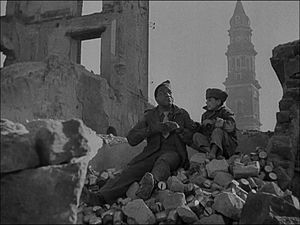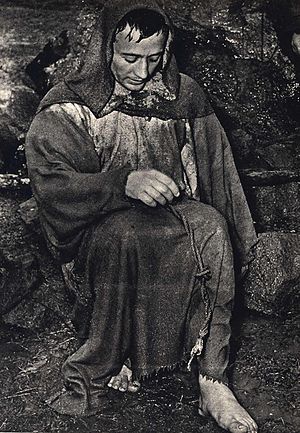Robert rossellini
Roberto Rossellini (Rome, Italy, May 8, 1906 - Rome, June 3, 1977) was an Italian filmmaker. Rossellini is one of the most important directors of Italian neorealism, to which he contributed with films such as Rome, Open City , Paisà and Germany, Year Zero .
Biography
Beginnings
He was born into a bourgeois family in Rome. His brother was the composer Renzo Rossellini. His father built the first Roman cinema Il Corso Cinema (a theater where movies could be shown), granting Roberto unlimited free admission; Roberto began to frequent the cinema at an early age. When his father died, Roberto worked as a film sound technician, and for some time was able to work in various fields related to film making, gaining proficiency in each.
In 1938 he shot his first short film, Prélude à l'aprés-midi d'un faune, after which he assisted Goffredo Alessandrini in the shooting of Luciano Serra pilota, one of the most successful Italian films of the first half of the century. In 1940 she assisted Francesco De Robertis at Uomini sul Fondo. His first feature film, La Nave Bianca (1941) is the first of the so-called "Fascist Trilogy", along with Un pilota retorna (1942) and Uomo dalla Croce (1943). His friendship and cooperation with Federico Fellini and Aldo Fabrizi correspond to this stage.
Neorealism
When the Fascist regime ended in 1945, just two months after the liberation of Rome, Rossellini was already preparing Rome, Open City (Roma città aperta, and Fellini collaborated on the script and Fabrizi participated in the role of the priest), which he produced himself, from which he obtained most of the money from credits and loans. This drama was an immediate success. Rossellini thus began his "Neorealist Trilogy", whose second film was Paisà (Comrade, 1946), filmed entirely with non-professional actors, and the third Germania anno zero (1947), sponsored by a French producer and directed in the French sector of Berlin.[citation needed]
He stated in an interview: "To really create the character one has in mind, it is necessary for the director to engage in a battle with the actor who usually ends up submitting to the actor's wishes. Since I don't want to waste my energy in a battle like this, I only use professional actors on rare occasions". It has been said that one of the reasons for his success was the fact that Rossellini rewrote the scripts according to the feelings and stories of his non-professional actors. Regional accents, dialects and dress are seen in his films the way they really were.
Following his "Neorealist Trilogy," Rossellini produced two feature films that today are classified as transitional cinema: L'Amore (with Anna Magnani) and La macchina ammazzacattivi, showing reality and truth.
The muse Ingrid Bergman
In 1949 Ingrid Bergman after seeing Roma Città aperta and Paisà decides to write a letter to Rossellini proposing to work with him and thus begins one of the best-known love stories in the world of cinema, with Ingrid Bergman and Rossellini at the height of their popularity and influence. They began working together a year later on Stromboli terra di Dio (on the island of Stromboli, 1950, whose volcano erupted during filming, and in Europa '51 (1951). In 1954, Viaggio in Italia completes the so-called "Ingrid Trilogy." This last film has a great influence in France, where it is recognized by Cahiers du Cinéma as one of the stylistic origins of the Nouvelle Vague.
This relationship caused a great scandal in some countries, since both Bergman and Rossellini were married before they met; the scandal escalated when they began having children (one of whom is Isabella Rossellini).
Switch to television
In 1965, Rossellini decided to move from cinema to television, stating that the latter, being a cold medium and aimed at a mass audience, could improve communication with viewers in the cinema, considered regressive. He compared the movie to The Matrix because it was too protective of the viewer. He thinks of television as a teaching medium, capable of communicating history and transmitting culture more effectively than school and books.
He began his encyclopedic project with geography to later go down in history: it was essential for Rossellini because it explains our being, our past, present and future. Man is made in history. His work for television can be divided into:
1. The portraits of characters (Socrates, Descartes, Pascal, Augustine of Hippo, Louis XIV)
2. Period portraits (The Age of Cosimo de' Medici, Acts of the Apostles).
Period portraits differ from the former in that they are much more time consuming and specific, while character portraits follow an idea. With the exception of Socrates and Cosimo, the trajectory of the characters takes place in a period of 20-30 years.
His TV movies can be considered part of an encyclopedic project, as if the movies were part of the same work. The Seizure of Power by Louis XIV is the only one of the television movies shown in theaters.
Inventions (Pancinor)
Before dedicating himself completely to cinema, Rossellini was noted for his great interest in mechanics. In this way, he built a workshop to be able to experiment and test his new inventions, which were really ingenious.
Among the most notable is a version of the pancinor, a photographic lens invented by engineer Roger Cuvillier France in 1949. Rossellini's version consisted of a modified 25/250mm zoom. This one had a remote control that he himself monitored and two interlock motors.
Rossellini was able to put it into practice on the set of Era notte a Roma (1960). From the moment of his creation, he used it in all of his subsequent works. Therefore, this is a characteristic feature in his filmography.
Filmography
Cinema
- The British ship (1941)
- A pilot ritorna (1942)
- L'uomo dalla croce (1943)
- Roma città aperta (Rome, open city(1945)
- Desiderio (1946)
- Paisà (1946)
- Germania anno zero (Germany, year zero(1948)
- L'amore, episode A voce umana and Il miracolo (1948)
- Stromboli terra di Dio (Stromboli(1950)
- Francesco, giullare di Dio (1950)
- Invidia (episode) I sette peccati capitali, 1952)
- The macchina ammazzacattivi (1952)
- Europe '51 (1952)
- Ingrid Bergman (episode) Siamo donne, 1953)
- Viaggio in Italy (I will always love you(1954)
- Napoli '43 (episode) Amori di mezzo drylo1954)
- Dov'è la libertà? (1954)
- The paura (1954)
- Giovanna d'Arco al rogo (1954)
- India (1959)
- Il generale Della Rovere (General de la Rovere(1959)
- It was noticeable to Rome (Fugitives at night(1960)
- Viva l'Italia! (1961)
- Vanina Vanini (1961)
- Anima nera (Black soul(1962)
- Illibatezza (episode) Ro.Go.Pa.G.1963)
- The Prise de pouvoir par Louis XIV (TV, 1966)
- Anno one (Year one(1974)
- Il messia (1975)
Television
- L'India vista da Rossellini (TV Series, 1959)
- Torino nei cent'anni (TV, 1961)
- L'età del ferro (TV, 1964)
- The Prise de pouvoir par Louis XIV (TV de France, 1966)
- Idea di un'isola (TV, 1967)
- Atti degli apostoli (Minister TV, 1969)
- Socrate (TV, 1970)
- Rice University (1971)
- Intervista a Salvador Allende: Forza e la ragione (1971)
- Blaise Pascal (TV, 1971)
- Agostino d'Ippona (1972)
- L'età di Cosimo de' Medici (TV, 1973)
- Cartesius (TV, 1969)
- Concerto per Michelangelo (TV, 1977)
- Beaubourg, centre d'art et de culture Georges Pompidou (1977)
Awards and distinctions
- Oscar Awards
| Year | Category | Movie | Outcome |
|---|---|---|---|
| 1950 | Best argument and script | Paisà | Candidate |
- Cannes International Film Festival
| Year | Category | Movie | Outcome |
|---|---|---|---|
| 1946 | Grand Prix | Rome, open city | Winner |
- Venice International Film Festival
| Year | Category | Movie | Outcome |
|---|---|---|---|
| 1946 | Special mentions | Paisà | Winner |
| 1952 | International Prize | Europe 51 | Winner |
| 1959 | Golden Lion | General de la Rovere | Winner |
| Special mention | Winner | ||
| OCIC Award | Winner |
Contenido relacionado
La boheme (Puccini)
Ganges
Silence (music)


